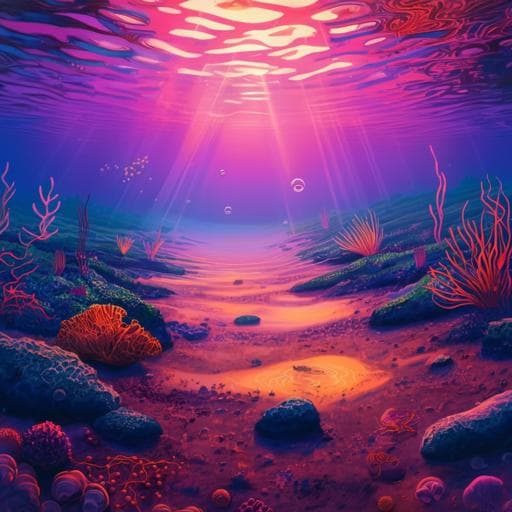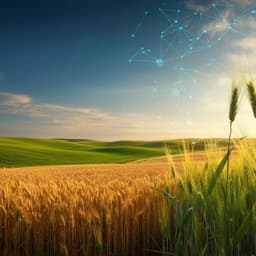
Biology
Weakened resilience of benthic microbial communities in the face of climate change
L. Seidel, M. Ketzer, et al.
This fascinating research by Laura Seidel and colleagues delves into how 50 years of warming has transformed benthic microbial communities in a Baltic Sea bay. The study reveals alarming reductions in oxygen levels and increased production of toxic substances, hinting at a precarious balance in coastal ecosystems. Discover how rising temperatures might be triggering a negative feedback loop affecting biogeochemical cycling.
~3 min • Beginner • English
Introduction
Climate change is warming oceans, increasing CO2 and acidification, salinity, stratification, de-oxygenation, and sea levels. European seas have warmed ~0.01 °C per year since 1860 and are projected to warm up to ~2 °C down to 100 m by 2100. Microbes drive marine energy and nutrient cycles, and their responses to warming will affect global biogeochemistry and ecosystems. Hypoxia in the Baltic Sea has expanded ten-fold in a century, with temperature-driven oxygen decline compounded by higher microbial metabolic rates. Coastal waters are particularly sensitive, with rapid heat transfer to sediments and likely longer seasonal hypoxia. Seasonal dynamics at higher latitudes shape nutrient cycling and organic matter fluxes; perturbation by warming may weaken the biological pump. Despite microbes’ rapid responses to climate change, the amplification of effects through coastal sediment food webs remains poorly understood. This study leverages a Baltic Sea bay warmed for ~50 years by a nuclear power plant’s cooling-water discharge (average +3.3–5.7 °C, within RCP5-8.5 ranges) as a natural laboratory, compared to a nearby control bay. Research questions: (1) How does 50 years of warming affect microbial community diversity and structure? (2) How does increased warming influence microbial energy and nutrient cycling? (3) Did warming result in phenological shifts? (4) What are the consequences of these effects under future climate change?
Literature Review
- Experimental warming often reduces local richness across ecosystems (~8.9%), but predictions are frequently based on short-term, fixed-temperature laboratory studies that may not capture long-term, fluctuating natural systems.
- The Baltic Sea experiences eutrophication, higher biomass production, and increased oxygen consumption, leading to widespread hypoxia. Temperature increases accelerate hypoxia by lowering O2 solubility and boosting microbial metabolism.
- Coastal shelves are variable and growing sinks for atmospheric CO2, with coastal oxygen declines outpacing the open ocean and seasonality exerting strong control on ecosystem functions and sediment organic matter dynamics.
- Microbes rapidly respond to climate change due to short generation times and phenological shifts; however, cascading effects in coastal sediment food webs are not well resolved.
- Prior Baltic studies show sediment microbial communities are strongly structured by oxygenation status and support cryptic sulfur cycling; yet, long-term, in situ warming effects on benthic microbiomes and geochemistry remain underexplored.
Methodology
Study design: Two Baltic Sea bays near Oskarshamn, Sweden, were compared: a heated bay receiving cooling-water discharge from a nuclear power plant for ~50 years, and a nearby control bay (~1.5 km away) without artificial warming. The cooling water intake is from open coastal water at 16–18 m depth, warmed up to ~10 °C above ambient during reactor cooling (no direct reactor contact), yielding an average bay-scale warming within RCP5-8.5 predictions (3.3–5.7 °C by 2100).
Sampling: Bottom sediments were collected on four occasions spanning 2018–2019 (May, June, Nov 2018; Mar 2019) at three sites per bay (n=9 cores per bay per sampling). A kajak gravity corer retrieved acrylic cores (7 cm ID, 60 cm length). The 0–1 cm sediment layer was sliced for nucleic acids and chemistry. Bottom and surface water were measured in situ; temperature series were recorded with HOBO data loggers at three sites per bay.
Geochemistry: Bottom-water temperature, oxygen, salinity; sediment porewater (0–1 cm) nitrite, nitrate, phosphate, iron (total and ferrous), sulfate; sediment organic matter (loss on ignition). Sulfate concentration profiles and downward diffusive fluxes were determined at 6 cm depth at three sites across two bays for three sampling times (June 2018, Nov 2018, Mar 2019).
Molecular analyses: DNA (250 mg sediment) was extracted for 16S rRNA gene amplicon sequencing; PCR and Illumina library prep per Lindh et al. 2015. Sequences processed with DADA2 (v1.16) on UPPMAX; downstream analyses in R. RNA (from 2 g sediment) was extracted, stored at −80 °C, processed and sequenced at DOE JGI; QC filtering by JGI. Metatranscriptomic reads were annotated, counts transformed (VST) and analyzed.
Statistics and bioinformatics: Beta diversity via CCA (amplicons) with environmental vectors; PERMANOVA for community differences. PCA on VST-transformed RNA transcripts. Diversity metrics (Shannon’s H, evenness, Chao1). Differential abundance of ASVs and transcripts using DESeq2 (adjusted p<0.05); highly significant transcripts defined by |log2 fold change| ≥ 4. Sulfate fluxes computed from concentration gradients. Comparisons between bays via GLM/ANOVA as appropriate. Data and code availability provided (NCBI BioProject PRJNA739524; JGI IMG proposal ID 503869; GitHub repositories for processing pipelines).
Key Findings
- Thermal regime: The heated bay was on average 5.1 °C warmer than the control (means ± s.d.: control 10.9 ± 3.6 °C; heated 16.8 ± 4.3 °C), with greater differences Oct–Feb and little difference Jun–Aug. No significant surface–bottom temperature stratification in the heated bay (GLM ANOVA F9,62=0.01, p=0.929) vs. a thermocline in the control (F9,62=27.03, p<0.0001).
- Geochemistry (0–1 cm porewater unless noted):
- Oxygen (bottom water) lower in heated bay: 9.76 ± 4.3 vs. 10.76 ± 3.6 mg/L (GLM ANOVA F17,49=9.84, p=0.0028).
- Organic matter higher in heated bay: 42.3 ± 8.9% vs. 37.2 ± 6.9% LOI (ANOVA F17,49=11.39, p=0.0144).
- Nitrite higher (variable) in heated bay: 1.59 ± 1.5 vs. 0.98 ± 0.42 μM; nitrate lower: 42.85 ± 36.6 vs. 48.16 ± 24.1 μM (F17,49=4.96, p=0.03).
- Ferrous iron higher (more variable) in heated bay: 5.56 ± 3.2 vs. 5.12 ± 0.5 μM.
- Sulfate lower in heated bay: 2.04 ± 1.2 vs. 2.52 ± 1.3 mM (F17,49=13.95, p=0.005).
- Phosphate slightly lower in heated bay: 201.3 ± 109.4 vs. 223.1 ± 103.7 μM.
- Sulfate flux (6 cm depth) approximately doubled in heated bay: average 1.74 vs. 0.83 × 10^-9 mmol/cm²/s; sulfate concentration at 6 cm lower: 2.92 vs. 4.01 mM (heated vs. control).
- Interpretation: Thinning/shallowing of anaerobic zones (sulfate reduction and methanogenesis) towards sediment–water interface in heated bay.
- Microbial diversity and community structure (0–1 cm):
- Higher diversity in heated bay: Shannon’s H 6.22 ± 0.6 vs. 5.28 ± 0.9 (ANOVA F17,49=59.78, p<0.001); evenness 0.88 ± 0.04 vs. 0.77 ± 0.09 (F17,49=234.93, p<0.001); higher richness (Chao1: 1306 ± 566 vs. 1097 ± 496).
- Communities differed significantly between bays (CCA; PERMANOVA F=13.99, p=0.001); key drivers included temperature, depth, and location.
- Heated bay enriched for anaerobic and sulfur-cycling taxa (e.g., Desulfomicrobiaceae, Desulfocapsaceae, Woesiaceae); control enriched for Hydrogenophilaceae, Flavobacteriaceae, Ignavibacteriaceae. Elevated aerobic OM-degraders (e.g., Arenimonas) present year-round in heated bay, potentially sustaining oxygen consumption.
- Cyanobacteria abundant in both bays (higher relative abundance in control), but transcript data indicated year-round activity in heated bay vs. seasonal peaks in control.
- Metatranscriptomics (functional activity):
- Broad differences with >500 significantly different transcripts per bay (|LFC| ≥ 4, adjusted p<0.05).
- Heated bay showed higher transcripts for dissimilatory sulfate reduction (e.g., dsvB LFC 4.26 vs. −2.75; aprAB ~3.8–3.9; qrcBCD ~5.0–5.35) and methanogenesis (fdhAB 5.1, 5.25; cooS 5.25 vs. −2.89; acsAC 4.47–4.81 vs. −2.36 to −3.57), plus archaeal mcrBC.
- Control bay showed higher transcripts for oxygen-requiring processes: methanotrophy (pmoA1 mean LFC −3.47 vs. 3.18 in heated) and aerobic sulfur oxidation (fccB −4.4 vs. 2.63 in heated), consistent with higher oxygen.
- Energy production: ATP synthase transcripts higher in heated bay; sediment OM content also higher, indicating increased productivity.
- Photosynthesis: Higher PSI/PSII gene transcripts in control (seasonal cyanobacterial blooms), while heated bay exhibited all-year cyanobacterial activity.
- Stress and repair: Heated bay had many heat-stress chaperones (e.g., hspA 5.31 vs. −4.09; dnaK 4.62 vs. −3.59; groS 4.62 vs. −3.46; ibpA 3.99 vs. −3.59) and DNA repair/recombination transcripts, indicating thermal stress and incomplete adaptation after decades of warming.
- Overall: Prolonged warming compressed redox zones, increased sulfate reduction and methanogenesis near the sediment surface, and extended cyanobacterial activity, with potential for enhanced sulfide and methane release into oxygen-deficient waters.
Discussion
The long-term, in situ warming of a coastal bay selected for higher and more stable microbial diversity in surface sediments (0–1 cm), dominated by anaerobic and sulfur-cycling taxa, consistent with lower oxygen and increased organic matter accumulation. Geochemical indicators and fluxes demonstrated thinning of redox stratification, bringing sulfate reduction and methanogenesis closer to the sediment–water interface. Functional transcripts corroborated elevated anaerobic metabolisms and energy generation in the heated bay, while oxygen-requiring processes were more active in the control bay. Year-round cyanobacterial activity in the heated bay suggests a phenological shift, potentially intensifying seasonal and spatial anoxia. Despite increased energy production, elevated stress and repair transcripts in the heated bay indicate that microbial communities remain thermally stressed and not fully adapted after ~50 years, implying weakened resilience. These changes at the base of coastal biogeochemical cycles may create a negative feedback loop: warming promotes cyanobacterial production and organic matter deposition, further depleting oxygen, compressing redox zones, and enhancing sulfide and methane release, which can exacerbate climate change impacts and coastal dead zones.
Conclusion
Working in a natural, seasonally fluctuating system, the study shows that ~50 years of warming reshaped benthic sediment microbiomes toward more diverse but thermally stressed communities with reduced seasonal variability, compressed geochemical zonation, elevated sulfate reduction and methanogenesis near the sediment surface, and prolonged cyanobacterial activity. While warming increased energy production, widespread stress and repair responses suggest incomplete thermal adaptation and weakened community resilience. These shifts may foster a negative feedback loop of enhanced cyanobacterial blooms, organic matter degradation, oxygen loss, shallow redox zones, and potential methane emissions to already oxygen-deficient waters. Future research should test the generality of these responses across additional thermally altered coastal sites and incorporate replicated, multi-bay designs to disentangle warming from other environmental drivers.
Limitations
- Site-level confounding: Besides temperature, other environmental factors likely differ between bays (e.g., nutrient inputs), and a fully replicated multi-bay design was not feasible.
- Influence of intake water: Although analyses suggest minimal impact of inflowing open Baltic Sea microbes on benthic communities, some exchange cannot be entirely excluded.
- Depth constraints: Sampling sites were relatively shallow (1.2–4.9 m), allowing reoxygenation; findings may differ in deeper, persistently hypoxic systems.
- Generalizability: Results from a single thermally impacted bay may not universally represent coastal sediments worldwide; additional thermally altered systems should be examined.
- Radioactivity not a factor: Radiation levels in the heated bay were at or below natural background/fallout levels, but other unmeasured factors could still contribute.
Related Publications
Explore these studies to deepen your understanding of the subject.







